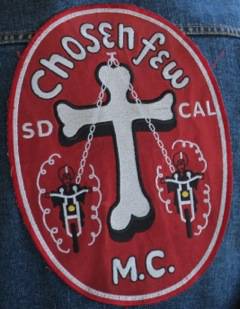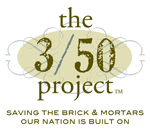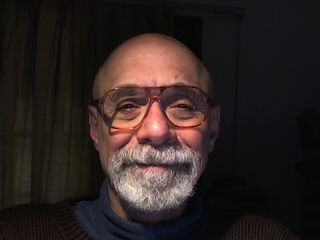
by Timothy Rutt
Elliot Michael Gold is mostly known around Altadena as one of the forces behind the Upside Down T Neighborhood Association and the Altadena Coalition of Neighborhood Associations. He recently retired after 33 years as a “teleconferencing guru” with his own business.
And as with many retirees, it’s a time to catch up on things -- in his case, finishing the book he started 40 years ago.
It started for Gold when bikers came roaring into a school gym
An engineer and statistician with JPL, “in the late 60s-early 70’s, I was involved in the sheriff’s department in Altadena, and I used to go to their community meetings,” Gold recalled. One meeting in 1971, held in a local school gymnasium with sparse attendence, was interrupted by a loud noise.
“As we started to ask questions, there was a noise that became a rumble, became a roar, and became the sound of motorcycles riding INTO the gymnasium ... riding down the center aisle, in the building,” Gold said.
About a dozen bikers came through the back doors and into the gymnasium, engines roaring. The deputies drew their guns, but were waved off by Lt. Clarence “Sonny” Elmore of the Altadena Sheriff’s Station. Elmore, it seems, had invited them to the meeting -- and he was a bike rider himself.
“These fellows are members of the Chosen Few, and they have better things to do with their time than to come to a meeting with sheriff’s deputies,” Gold recalls Elmore saying. “But here they are, outnumbering your other residents of the neighborhood.”
 Gold began taking pictures, because that’s what he did -- he was also a freelance photographer for Time Magazine. Gold’s pictures were published in one of the local papers, and over the course of months, there would always be members of the Chosen Few attending the sheriff’s meetings. Lt. Elmore introduced Gold to the Few, which led to him going to the Pasadena chapter’s clubhouse to share prints and take more pictures.
Gold began taking pictures, because that’s what he did -- he was also a freelance photographer for Time Magazine. Gold’s pictures were published in one of the local papers, and over the course of months, there would always be members of the Chosen Few attending the sheriff’s meetings. Lt. Elmore introduced Gold to the Few, which led to him going to the Pasadena chapter’s clubhouse to share prints and take more pictures.
The story of Gold and the Chosen Few is related in his new ebook, The Chosen Few: Bikes, Babes, and Booze, a 40-Year Look at an Outlaw Motorcycle Club, 1972-2012.
Back in 1972, Gold conceived the idea to write a picture story, and perhaps a book, about the club. The Chosen Few were an interesting club: starting out as a black club, they were the first to break the color line and admit whites and Hispanics.
“I set out to discover how a racially mixed outlaw motorcycle club came about and had existed so successfully for over twelve years, while other bike clubs were traditionally split on racial lines,” Gold wrote.
The club agreed to have him follow them around. In current parlance, Gold was an “embedded journalist” in the Chosen Few -- never a member, always a “citizen,” as they were called, but a presence on their runs, in the clubhouse, and in their lives. Dubbing him “Cameraman,” he spent two years taking pictures and taping interviews as they talked about living as outlaw bikers.
“I found that this particular club was not what I expected,” Gold said. “They were human beings. Now, that said, there were dope dealers, there were thugs, there were people who were cheating on their wives -- and there were businessmen, there were engineers, there were Ph.D.’s -- it was unbelievable.
“I went with them all around the state, on their runs, and on their activities. And I could not believe that when I was with the Chosen Few, I never had to worry about the thugs. The ones who were the dope dealers would protect me. But the ones who were the businesspeople were the ones I could not trust. What I learned was that they had the perception was that outlaw bikers were what they wanted to be, and they wanted to be thugs on the weekends.”
In the end, Gold couldn’t get a publisher interested in the book -- they loved the photographs, not so much his writing, he said -- and he put it aside when he went to back to school to get a sociology degree, and never returned to it.

But in 2010, he got a call from one of his subjects (club name: The Kid), who wondered where his book went -- and convinced him to finish it.
Over the course of the next two years, Gold tracked down and re-interviewed some of his 1972 subjects or their widows, to see what 40 years had done. Some of them had settled into more-or-less normal middle class lives (“The Kid,” for example, is a successful businessman with investment properties in Hawaii). Some fought drug and alcohol addictions. One got in touch with his Native American roots and became a pipe carrier, a high spiritual honor. However they spent the 40 years in between, whether they were still riding or not, they held great pride in their club membership.
Gold's book is centered around his interviews with the members of the club -- both the ones he taped in the 1970's, and ones he's taped since 2010, interviewing the same bikers 40 years later. He also interviews their wives and girlfriends, now and then, as they talk about the distaff side of the biker life. The boastful outlaw bikers of the 1970's return as workers, businessmen, retirees, fathers and grandfathers, maybe a little sadder and wiser, but still feeling attached to the biker's life, and the freedom of the open road.
Bernard Melekian, Pasadena’s retired chief of police, wrote of Gold’s book, “I was highly skeptical that I would have any interest in learning about the lives of some outlaw motorcycle gang members .... I found it almost impossible to put it down ... it should be sufficient to say that I was reminded of our common humanity.”
The books is available at its website:
http://www.thechosenfewbook.com/
or through Amazon:
http://www.amazon.com/dp/B00FQSY3AY




